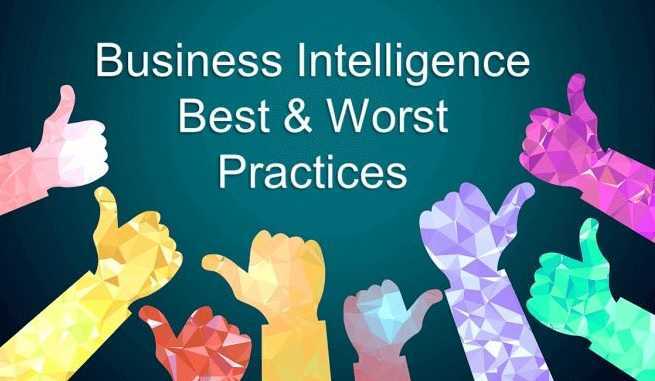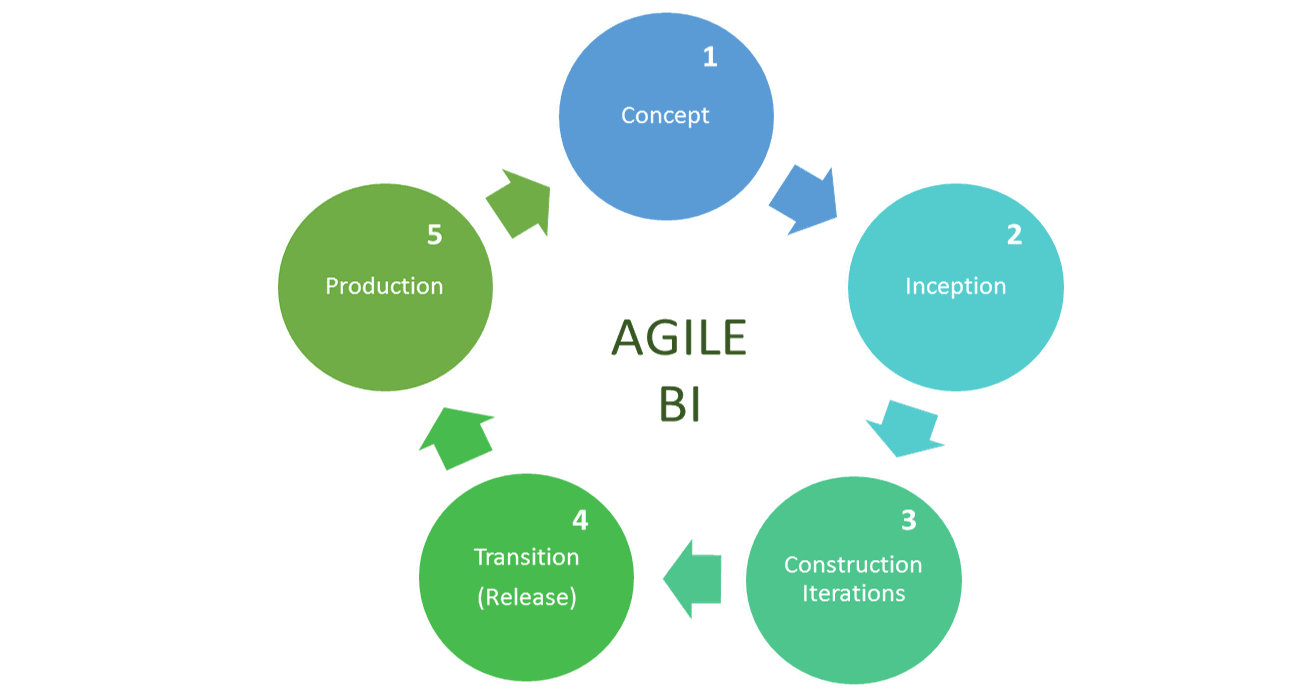The Top 5 Business Intelligence Best & Worst Practices You Should Know

Business intelligence software is quickly becoming a mainstay for organizations of all sizes. The resulting success stories are pouring in. Armed with BI, these companies are promoting cost efficiency, optimizing inventory levels, reducing waste, improving business processes and, in general, providing departments across their organization with the data they need to succeed via interactive dashboards. Many organizations have heard these success stories and are jumping onboard the BI train. However, recognizing the importance of data and analytics is one thing; meeting the needs of business decision-makers in the most efficient and appropriate way is a different matter. To do this you need the proper processes and tools in place and you need to follow best practices. We have already provided you with the top BI dashboard best practices. To ensure you get the desired value out of your BI investments and get you on the path to success we have come up with a top 5 of business intelligence best practices and a top 5 business intelligence worst practices you must know.
Uncover the potential of BI & benefit from advanced data analytics.
Top 5 Business Intelligence Best Practices
1. Get organization wide buy-in
Disjointed BI practices and failed universal adoption is a quick path to BI failure. To maximize BI success it is essential to get organization wide buy-in. It is in everyone’s best interest; in the end every department especially Sales, Marketing, Finance, and Management will benefit from BI. To that end the right parties should be involved from the get go. This best practice includes getting CIOs and CMOs to collaborate from the beginning!
IT is another key stakeholder you should involve from the beginning. Yes, the right SaaS BI tool won’t require IT heavy lifting. This doesn’t mean IT shouldn’t be included in analytics procurement, implementation, and management processes. IT and Dev teams offer valuable knowledge bases that should be utilized. They can ensure that appropriate security and governance measures are adhered to. IT is a great resource for knowledge retention and knowledge transfer. In the end, IT doesn’t necessarily have to manage the BI but they should be kept in the loop.
2. Have a plan, from the beginning
Approaching analysis without a strategy can cost you a lot of money, time and stress. Before you even choose a BI tool you need to identify the top business needs and develop a set of business requirements and goals. Don’t develop these in a vacuum or just at the executive level. Since you already have organization wide buy-in (right?!) consult with all key stakeholders, including finance, marketing, sales and operations. In the end setting clear objectives and having pre-determined key performance indicators (KPIs) will help guide a successful BI adoption.
3. Start Small
Odds are there are a lot of business questions you want answered and insights you need to gain. When you start to compile these needs and begin pondering the overall size of your data it is easy to get overwhelmed. This is only compounded when every employee starts clamoring for data immediately. This leads us to the next business intelligence best practice: start small. Start with a small list of crucial questions. Try to answer them with easily available data. If you end up with answers, then great. Odds are this process will lead to more questions that you can add to your roadmap. This process will also help you discover what data sources you need to compile, or what data you are missing in general. When it comes to BI rollouts, we are fans of Agile methodology best practices which promote an iterative approach that constantly involves stakeholders. Gather requirements and input, build, test, and repeat!
4. Identify necessary data sources

Odds are your organization, no matter the size, is collecting data surrounding most business operations. The problem is this data is often spread across a variety of different systems and software. Data may be stored in various ERP systems, CRMs, databases and Excel spreadsheets. With data spread across multiple systems, getting the information you need can be an arduous task. This is where you once again need to start small and identify the necessary data sources to get started. View your data not as an overwhelming mass but as a collection of answers to specific questions. Approach it with a question or a hypothesis in mind and check if the data gathered confirms your assumption. In the end you may take advantage of a data warehouse to improve performance. With the right tool you can easily compile and blend various data sources.
5. Foster a data culture
To get your organization on board with a new BI plan you are going to have to evangelize the importance of data. For your BI to succeed your organization needs to foster a data culture. When all departments of a company are working together towards a common goal, the resulting data insights and subsequent actions will be more meaningful and valuable.
There may be push back. Departments may be discouraged by a lack of time, data acumen and resources and shy away from encouraging enterprise adoption of BI. They may not see that the adoption costs outweigh the benefits. They need to see that the right tool will benefit all teams.
Some users may just be overwhelmed by new technologies and data. This can lead to change resistance. Work to show that while a little training may be necessary the right tool will easily empower everyone to be their own analyst. Look for a tool that allows for a wide range of users to easily connect to, explore, visualize and communicate their data. Easy drag and drop interfaces that require little training and no prior data analysis or SQL skills will also drive adoption. Empowering staff with business dashboards they can immediately use encourages them to make fast and confident decisions, and benefits the company as a whole.
Uncover the potential of BI & benefit from advanced data analytics.
Top 5 Business Intelligence Worst Practices
1. Build EVERYTHING on Day 1
New technologies are exciting. Having access to previously isolated data is even more exciting. It is easy to want to open the flood gates and build dashboards for everything. Don’t do this. As we stated before: start small. Otherwise, you will end up with a bunch of noise and unused reports/dashboards. Even worse: without controlling the data analytics flood you may end up with misleading dashboards being shared. The last thing you want to deal with is the pitfalls of data misinterpretation. Poor data management is also the quickest way to lose faith in a BI system and kill a data culture.
2. Give everyone access to BI immediately
In the same vein, don’t create a flood of new BI users. If they aren’t using the system, or don’t need it: don’t provide access. Make sure users are properly trained and that appropriate governance is in place. As a rule, proper governance should ensure assets are implemented and used according to agreed-upon policies and procedures; it should also ensure that these assets are properly controlled and maintained; and finally ensure that these assets are supporting your organization’s strategy and business goals. In today’s cloud based world, it can be difficult to maintain full control over the provisioning, de-provisioning and operations of infrastructure. This is another reason to get IT involved in selecting, brokering, and governing BI tools. Also look for a partner that provides governance support and best practices.
3. Make it perfect in the beginning and walk away
Your BI isn’t going to be perfect. It is a BI worst practice to think it is. Big data gives insights into real-time data enabling you to make changes immediately, right at the point when you see that a certain trend is emerging. The important word in that sentence: changes. Your market, competition, business landscape, and organization keep changing. Your BI will have to as well. Remain Agile by returning to the drawing board at regular intervals. In the end you may have to scrap whole dashboards. This is all part of the process towards BI success.

4. Only use Excel when it’s absolutely necessary
Excel shouldn’t be your default BI platform. It is as simple as that. We know this can be hard. Most of us feel comfortable with Excel. It’s been a staple for so long! But Excel was not made for business intelligence. For starters with Excel it is easy to run into data integrity issues, the data isn’t real time, spreadsheet maintenance quickly turns into a full time job, and collaboration is tough and opens up all sorts of governance issues.
Interactive live dashboards on the other hand quickly engage end-users with a wide range of technical acumen and provide an intuitive experience and easily digested insights. They also provide ROI by quickly highlighting trends and dig out irregularities. It may take a while to move your BI culture out of Excel, but it is worth it. If users are downloading dashboards to Excel to better understand the data, they need more training, or the dashboard may need to be built better.
5. Don’t talk about security when vetting BI systems
Security has been a concern from the start of cloud computing technology, and for good reason as you are unable to see the exact location where your data is stored or being processed. Headlines highlighting data breaches and nation sponsored hacking campaigns haven’t helped alleviate those concerns. Not voicing them nor properly vetting BI options is a business intelligence worst practice.
Luckily, security capabilities are constantly improving. To ensure your organization’s privacy and security are intact, you just need to verify the SaaS provider has secure user identity management, authentication and access control mechanisms in place. Also, check which data security and privacy laws they are subject to. While you are auditing a provider’s security and privacy laws, make sure to also confirm compliance. Your organization needs to be able to comply with regulations and standards, no matter where your data is stored. Speaking of storage, also ensure the provider has strict data recovery policies in place.
Uncover the potential of BI & benefit from advanced data analytics.
Use This List to Maximize Your BI Investments
Organizations are reaching new levels by capitalizing on emerging innovative BI solutions. The most effective organizations are maximizing their BI investments by following business intelligence best practices and avoiding BI worst practices. They are also ensuring that they are investing in the right tool for their organization. This starts with determining if an on-premise BI vs cloud BI strategy works best for your organization.
After that, make sure you have a business intelligence software that allows you to connect to various data sources and interact with, visualize, and communicate that data. Ensure it also leverages Web-based, parameter-driven forms, personal end-user scheduling for regular e-mail delivery, and alternate output options (e.g. HTML, Excel, PDF) to give end users flexibility. Then get unearthing exciting and actionable insights! Armed with the right tool and business intelligence best practices, your BI will be unstoppable.